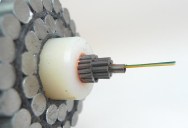The Undersea Cables that Connect the World
by twistedsifter

What you see above is a submarine communications cable. With a diameter of 69 millimeter (2.7 inches), it carries 99% of all international traffic (i.e., internet, telephony and private data) and connects every continent on Earth with the exception of Antarctica.
These amazing fibre optic cables traverse oceans and span hundreds of thousands of kilometers. Below you will find pictures, descriptions and links to much more informative resources about this incredible network of cables that connect our planet.
Map of the Worldwide Undersea Submarine Cable Network
This is a map of all undersea cables around the world. It is a screen capture from https://www.submarinecablemap.com/ an interactive website that let’s you zoom, pan and locate every known submarine cable in the world. Information about the company that owns cable and the various landing points of each cable is also provided.
This is the CS Cable Innovator, it is specifically designed for laying fiber optic cable and is the largest of its kind in the world [source]. Built in 1995 by Kvaerner Masa of Finland, it is 145 meters in length (476 ft), with a breath of 24 meters (78 ft) and a depth of 8.5 meters (28 ft). It is capable of carrying up to 8500 tons of fibre optic cable. [source]
The ship has 80 cabins, of which 42 are officer cabins, 36 are crew cabins and two are representative suites. The normal endurance of the vessel at sea is 42 days, but this can be extended to approximately 60 days through logistical support. [source]
For additional information on this incredible ship please visit the following websites:
– https://www.ship-technology.com/projects/cable/
– https://atlantic-cable.com/Cableships/Innovator/index.htm
Originally, submarine cables were simple point-to-point connections. With the development of submarine branching units (SBUs), more than one destination could be served by a single cable system. Modern cable systems now usually have their fibers arranged in a self-healing ring to increase their redundancy, with the submarine sections following different paths on the ocean floor. [Source]

As of 2012, operators had “successfully demonstrated long-term, error-free transmission at 100 Gbps across Atlantic Ocean” routes of up to 6000 km, meaning a typical cable can move tens of terabits per second overseas. Speeds improved rapidly in the last few years, with 40 Gbit/s having been offered on that route only three years earlier in August 2009. [source]
Cross-Section of an Undersea Submarine Communications Cable
1. Polyethylene
2. “Mylar” tape
3. Stranded metal (steel) wires
4. Aluminum water barrier
5. Polycarbonate
6. Copper or aluminum tube
7. Petroleum jelly
8. Optical fibers
[source]
What are the environmental effects of laying a telecommunications cable on the seafloor? How does it affect the ocean bottom and the animals that live there? Although literally millions of kilometers of communications cables have been placed on the seafloor over the last century, few peer-reviewed scientific papers have documented the effects of these cables on marine life. A recent paper by researchers at MBARI and the Monterey Bay National Marine Sanctuary describes a unique biological survey of a cable on the deep seafloor off Central California. This survey found that the cable had only minor impacts on animals living on and within the seafloor.
In the photograph above we see a variety of marine life living near the Pioneer Seamount cable, which crosses the continental shelf offshore of Half Moon Bay. The animals in this image include several sea stars and basket stars, an anemone, and a number of young rockfish. For scale, the cable is about 3.2 cm (1.25 inches) in diameter. [Source: MBARI]

As of 2006, overseas satellite links accounted for only 1 percent of international traffic, while the remainder was carried by undersea cable. The reliability of submarine cables is high, especially when (as noted above) multiple paths are available in the event of a cable break. Also, the total carrying capacity of submarine cables is in the terabits per second, while satellites typically offer only megabits per second and display higher latency. However, a typical multi-terabit, transoceanic submarine cable system costs several hundred million dollars to construct. [source]
Sources
– Wikipedia: https://en.wikipedia.org/wiki/Submarine_communications_cable
– Submarine Cable Map: https://www.submarinecablemap.com/
– ship-technology: https://www.ship-technology.com/projects/cable/
– Atlantic Cable: https://atlantic-cable.com/Cableships/Innovator/index.htm
– MBARI: https://www.mbari.org/news/homepage/2006/cable.html
– Friends of Pleistocene: https://fopnews.wordpress.com/2011/03/24/incident-report-hudson-canyon-geologic-city-report-10/
– Reddit: https://www.reddit.com/r/cableporn/comments/l4d7y/what_it_takes_to_be_an_undersea_cable/
– Light Reading Europe: https://www.lightreading.com/document.asp?doc_id=180473
If you enjoyed this post, the Sifter highly recommends:

Sign up to get our BEST stories of the week straight to your inbox.




